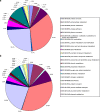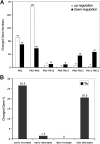Comparison of gene expression during in vivo and in vitro postnatal retina development
- PMID: 20072636
- PMCID: PMC2802513
- DOI: 10.1007/s12177-008-9009-z
Comparison of gene expression during in vivo and in vitro postnatal retina development
Abstract
Retina explants are widely used as a model of neural development. To define the molecular basis of differences between the development of retina in vivo and in vitro during the early postnatal period, we carried out a series of microarray comparisons using mouse retinas. About 75% of 8,880 expressed genes from retina explants kept the same expression volume and pattern as the retina in vivo. Fewer than 6% of the total gene population was changed at two consecutive time points, and only about 1% genes showed more than a threefold change at any time point studied. Functional Gene Ontology (GO) mapping for both changed and unchanged genes showed similar distribution patterns, except that more genes were changed in the GO clusters of response to stimuli and carbohydrate metabolism. Three distinct expression patterns of genes preferentially expressed in rod photoreceptors were observed in the retina explants. Some genes showed a lag in increased expression, some showed no change, and some continued to have a reduced level of expression. An early downregulation of cyclin D1 in the explanted retina might explain the reduction in numbers of precursors in explanted retina and suggests that external factors are required for maintenance of cyclin D1. The global view of gene profiles presented in this study will help define the molecular changes in retina explants over time and will provide criteria to define future changes that improve this model system.
Electronic supplementary material: The online version of this article (doi:10.1007/s12177-008-9009-z) contains supplementary material, which is available to authorized users.
Keywords: Cyclin D1; Functional genomics; Gene expression; Microarray; Retina development; Retina explant; Rod photoreceptors; System biology.
Figures









Similar articles
-
A biphasic pattern of gene expression during mouse retina development.BMC Dev Biol. 2006 Oct 17;6:48. doi: 10.1186/1471-213X-6-48. BMC Dev Biol. 2006. PMID: 17044933 Free PMC article.
-
Identification of the molecular signatures integral to regenerating photoreceptors in the retina of the zebra fish.J Ocul Biol Dis Infor. 2008 Dec;1(2-4):73-84. doi: 10.1007/s12177-008-9011-5. Epub 2008 Nov 18. J Ocul Biol Dis Infor. 2008. PMID: 20072637 Free PMC article.
-
Global gene expression analysis of the developing postnatal mouse retina.Invest Ophthalmol Vis Sci. 2004 Mar;45(3):1009-19. doi: 10.1167/iovs.03-0806. Invest Ophthalmol Vis Sci. 2004. PMID: 14985324
-
Dual role of Nr2e3 in photoreceptor development and maintenance.Exp Eye Res. 2008 Jul;87(1):35-48. doi: 10.1016/j.exer.2008.04.006. Epub 2008 Apr 25. Exp Eye Res. 2008. PMID: 18547563
-
Nonvisual photoreceptors of the deep brain, pineal organs and retina.Histol Histopathol. 2002 Apr;17(2):555-90. doi: 10.14670/HH-17.555. Histol Histopathol. 2002. PMID: 11962759 Review.
Cited by
-
Transcriptome profiling of Staphylococci-infected cow mammary gland parenchyma.BMC Vet Res. 2017 Jun 6;13(1):161. doi: 10.1186/s12917-017-1088-2. BMC Vet Res. 2017. PMID: 28587645 Free PMC article.
-
The Effects of Cannabinoids on Ischemic Stroke-Associated Neuroinflammation: A Systematic Review.J Neuroimmune Pharmacol. 2025 Feb 3;20(1):12. doi: 10.1007/s11481-025-10171-z. J Neuroimmune Pharmacol. 2025. PMID: 39899062 Free PMC article.
-
Microarray and morphological analysis of early postnatal CRB2 mutant retinas on a pure C57BL/6J genetic background.PLoS One. 2013 Dec 6;8(12):e82532. doi: 10.1371/journal.pone.0082532. eCollection 2013. PLoS One. 2013. PMID: 24324803 Free PMC article.
-
Immunocytochemical Profiling of Cultured Mouse Primary Retinal Cells.J Histochem Cytochem. 2017 Apr;65(4):223-239. doi: 10.1369/0022155416689675. Epub 2017 Feb 2. J Histochem Cytochem. 2017. PMID: 28151698 Free PMC article.
-
LSD1-Mediated Demethylation of H3K4me2 Is Required for the Transition from Late Progenitor to Differentiated Mouse Rod Photoreceptor.Mol Neurobiol. 2016 Sep;53(7):4563-81. doi: 10.1007/s12035-015-9395-8. Epub 2015 Aug 23. Mol Neurobiol. 2016. PMID: 26298666 Free PMC article.
References
-
- Seigel GM. The golden age of retinal cell culture. Mol Vis. 1999;5:4. - PubMed
Grants and funding
LinkOut - more resources
Full Text Sources
Research Materials
